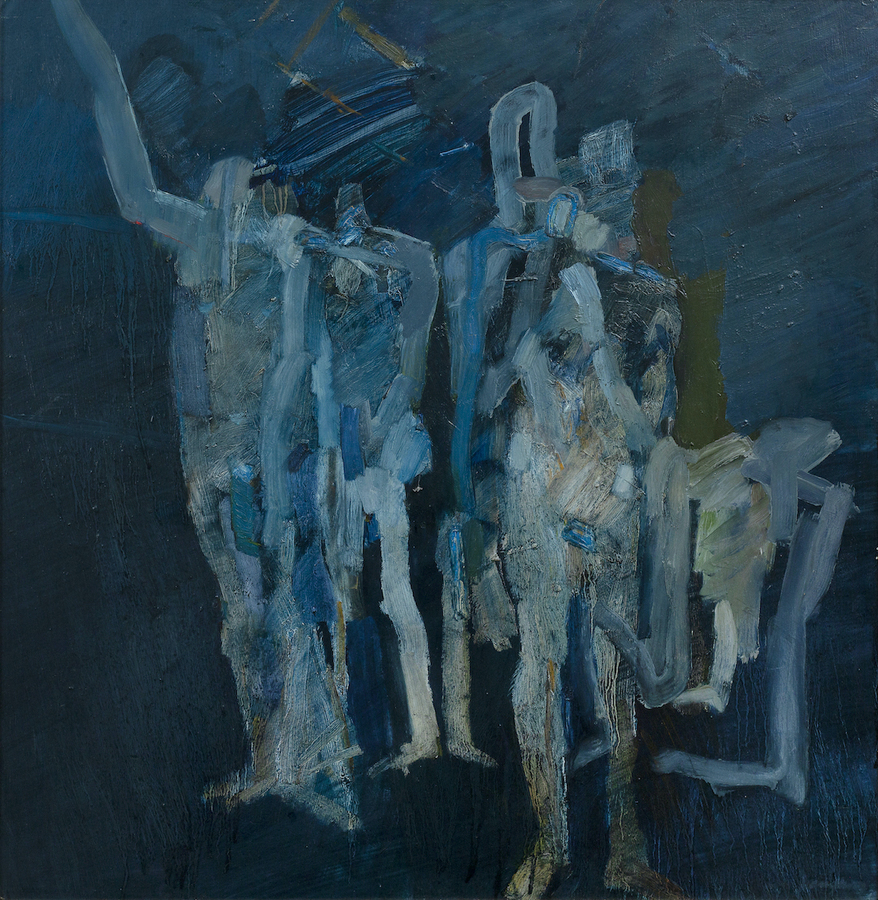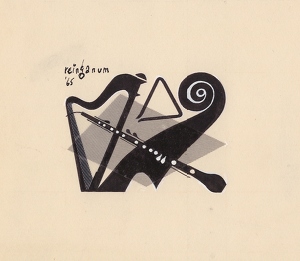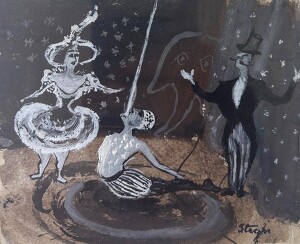

1912-1977
Blue Assembly
Ref: 1784
Signed: Keith Vaughan and titled and dated (reverse of board)
Oil on board, 25 by 24 ins
Provenance: with Marlborough Gallery, London, 1964; Mrs Mavroleon; M. Cohen; New London Art Gallery, London, Keith Vaughan, New Paintings (no.15, illustrated in catalogue); Christie’s, 11 June 1976, lot 172, where acquired by John Constable
Literature: Anthony Hepworth and Iain Massey, Keith Vaughan: The Mature Oils – A Commentary and Catalogue Raisonné, no.AH424, reproduced p.152
Assembling groups and congregations of figures occur throughout Vaughan’s oeuvre. In his earlier versions, the figures retain their individual identities, somehow psychologically insulated from their neighbours. In later versions, as we see here, figures interpenetrate one another and the individual becomes identified as part of the group while it jostles and collides against itself. The landscape rarely exists as a separate backdrop for the figures but is assimilated with them and it is not easy to determine where figures end and the landscape begins. The connections and interactions between the human forms and their association with their environment, is generally the overriding theme in Vaughan’s work. He wrote:
’I would like to be able to paint a crowd – that abstract entity referred to by the sociologists as the masses. An amorphous compressed lump of impermanent shape reacting as a mass to environmentally stimuli yet composed of isolated human egos retaining their own separate incommunicable identities. In the past artists have usually dealt with the problem of crowds by turning them into assemblies. Assemblies are orderly rhythmic groups of individuals which act and are acted upon by mutual consent. The behaviour of an assembly is at least compatible with that of any member composing it and often surpasses him in achievement. The behaviour of a crowd follows its own laws and generates its own energy. It is inferior, humanly speaking, to any one member composing it and usually acts contrary to his interests, and can even accomplish his destruction.’ (Keith Vaughan, Some Notes on Painting, August 1964)
No longer incorporated in the church or any codified system of belief, the Assemblies are deprived of literary significance or illustrative meaning. The participants have not assembled for any particular purpose such as a virgin birth, martyrdom, or inauguration of a new power station. In so far as their activity is aimless and their assembly pointless they might be said to symbolize an age of doubt against an age of faith. But that is not the point. Although the elements are recognisably human their meaning is plastic. They attempt a summary and condensed statement of the relationship between things, expressed through a morphology common to all organic and inorganic matter (Keith Vaughan, ‘Painter’s Progress’ from Studio, August 1958, p. 53).
A remarkable variety of textures here, demonstrates just how inventive and imaginative Vaughan’s technique had become. Translucent azure pigments are lightly brushed over the forms that appear ghost-like from beneath successive veils of paint. The effect is both subtle and haunting.
 Private Collection
Private CollectionEnquire




